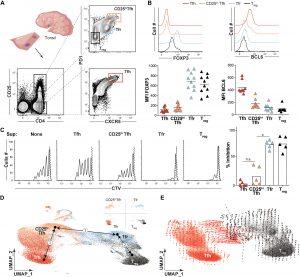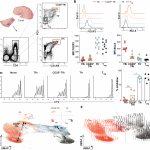According to a new study, researchers have described a regulatory class of human T cells which are derived from two distinct origins, one connected to autoimmunity and the other to protective immunity (Figure 1). This study demonstrated the existence of two distinct T cell lineages, demonstrating how the immune system may decrease inflammation brought on by autoimmune disease while promoting the survival of T cells that fight infection.

Figure 1: In silico models predict that Tfh and Treg cells each contribute to the Tfr pool. (A) A strategy to sort Tfh (CD4+CD25−CXCR5hiPD1hi, red), CD25hi Tfh (CD4+CD25hiCXCR5hiPD1hi, orange), Tfr (CD4+CD25hiCXCR5+PD1int, light blue), and Treg (CD4+CD25hiCXCR5−PD1−, black) cell subsets from a small tonsil wedge is depicted. (B) Histograms and plots display FOXP3 and BCL6 MFIs on indicated T cell subsets from a representative and all tonsil donors (n = 8 to 10). (C) Left: Representative histograms of CTV-labeled T cell responders stimulated (solid line) or not (dashed line) in coculture with indicated heterologous tonsillar T cell suppressor (Sup) subsets are displayed. Bar graph (right) represents mean percent inhibition relative to unstimulated Tresp cells (n = 5). n.s., not significant. (D) Dimensionally reduced scRNA-seq of TC174 T cell subsets are displayed as a UMAP. Pseudotime cell-ordered projections (black arrows) identify two Tfr developmental arcs, (①) to CD25hi Tfh and Tfh cells and (②) to Tregs. (E) RNA velocity vectors of only Tfh and Treg cells from TC174 are displayed. An arbitrary dashed centerline denotes convergence. *P < 0.05 by one-way ANOVA.
The tonsils, lymph nodes, and spleen all contain spherical collections of cells called germinal centres (GCs), which are in charge of coordinating interactions between B cells and T follicular helper (Tfh) cells. To define the origins, roles, and placements of Tfr cells inside GCs, the researchers used computational, in vitro, and in vivo methodologies.
The researchers were able to demonstrate that there are two subpopulations of Tfr cells—one that is induced by Tfh cells and is known as iTfrs and the other that was derived from Tregs, a subpopulation of T cells that is in charge of regulating the immune system—and they called nTfrs. Following the discovery of these two Tfr cell subpopulations, the researchers investigated if these two regulatory T cells expressed CD38 differently. They discovered that CD38 is expressed by iTfr cells but not by nTfr cells.
This finding could create new opportunities for therapeutic intervention.
Journal article: Le Coz, C., et al., 2023. Human T follicular helper clones seed the germinal center-resident regulatory pool. Science Immunology.
Summary by Stefan Botha
